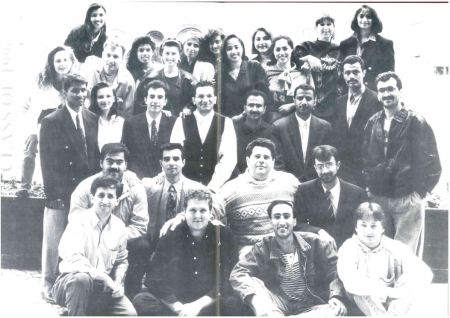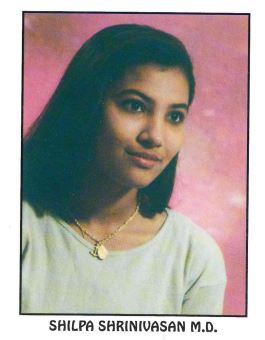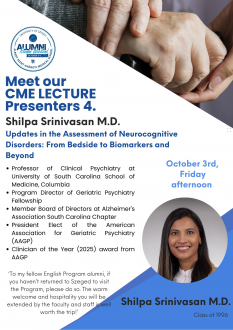University of Szeged
Albert Szent-Györgyi Medical School
Foreign Students' Secretariat
Your Education. Our Mission.

"It turned out to be the best educational and professional decision of my life"
Interview with Dr. Shilpa Srinivasan, Alumna of the Month By SZTE Alma Mater on October 29, 2025
By SZTE Alma Mater on October 29, 2025
Shilpa Srinivasan, M.D., DFAPA, DFAAGP is a Professor of Psychiatry at Prisma Health, University of South Carolina School of Medicine in Columbia, South Carolina, USA. A board-certified geriatric and general adult psychiatrist, she has built an impressive career in clinical practice, medical education, and leadership. In early October 2025, she returned to the Albert Szent-Györgyi Medical School, University of Szeged, SZOTE for the Medical Alumni Reunion, where she shared her expertise in geriatric psychiatry and was honored with the Outstanding alumna award. She described the event as “an honor, privilege, and a full circle moment,” cherishing the joy of reconnecting with colleagues and friends, some of whom she hadn’t seen in decades. In this interview, she reflects on her path from her early years in Dubai to her studies at the University of Szeged, and the journey that led her to become one of the inspiring voices in geriatric psychiatry in the United States.
Please introduce yourself!
My name is Shilpa Srinivasan. I am a geriatric and general adult psychiatrist by training and board certification, and a Professor of Psychiatry at Prisma Health, University of South Carolina School of Medicine in Columbia, South Carolina. I have been in clinical practice for coming up on twenty years.
My family of origin is from India, but I was raised in Dubai, in the United Arab Emirates. I come from a family that is very much rooted in higher education; many of my relatives are engineers or lawyers. My great-grandfather was a physician, but there weren’t many doctors in my immediate family. But when I was growing up, I had a clear idea that I wanted to be in the sciences, even as a child. I was fascinated by medicine and the biological sciences, so both culturally and personally I was sort of groomed in that trajectory.
How did you come to choose the University of Szeged?
At the time I graduated high school, Dubai didn’t have many institutions of higher learning, so I knew I would have to go abroad to study medicine. India was an option, but since I had never lived there, I also considered the United Kingdom, Australia, or the United States, but there were age restrictions – I actually graduated shortly before I turned 16, and most programs required students to be at least 18. Around that time, I heard from family friends about yearbookphoto4.JPGEnglish-language medical programs opening in Eastern Europe, as the geopolitical landscape there was changing. I learned about Hungary, through family friends who had started medical school there and spoke very positively about it, I decided to apply. I was waitlisted in Budapest at Semmelweis but accepted at SZOTE in Szeged. It was a courageous decision by my parents to allow their daughter to move to a different country and continent, but I’m so grateful to them because it turned out to be the best educational and professional decision of my life.

What cultural differences or shocks did you experience when you first arrived in Hungary?
On multiple levels, there was definitely some culture shock. First and foremost, there was an environmental and meteorological shock – coming from the Middle East, a desert region that is extremely hot, to Hungary, which was beautifully green and temperate. I still remember being struck by the parks, the squares, Széchenyi tér, and the trees everywhere. It was just so green, and the architecture was striking as well. Visually, it was a sharp contrast to the very urban environment I was used to in the Middle East.
Culturally, Hungary at that time was in a fascinating transition: emerging from communism and socialism into early democracy. The country was opening up in many ways, both literally and figuratively. For me, everyday things like figuring out public transport or shopping for groceries were new challenges, especially since everything was in Hungarian – and this was before cell phones or Google Translate! So there was a lot of trial and error, but those challenges were also deeply formative. The only way to grow is to experience new things, to be challenged, and to step outside your comfort zone. And it's happen only when we allow ourselves to experience something other than what we know.
Did you have a teacher or mentor at the University of Szeged who influenced or helped you, even with the small things?
Many teachers and faculty members who helped me navigate life more easily. My Hungarian language teacher, Máté Valéria, was phenomenal. She had an excellent grasp of English and really knew how to teach. She was also very strict – she expected effort, and I appreciated that, because Hungarian is not similar to any Latin-based language. Through her teaching, I learned not just medical Hungarian, but life Hungarian, how to manage daily life, talk to people, and integrate into the culture.
I also remember Bőti Zsuzsanna, one of the preclinical lecturers, who warmly welcomed us and introduced us to many cultural elements. And of course, Dr. Csillik Bertalan, our legendary anatomy professor, who was larger than life, internationally renowned, and so passionate about education. Seeing that kind of dedication helped solidify my belief that I had made the right choice coming to Szeged. There were many others I fondly remember: Dr. Benedek György, Dr. Janka Zoltán, Dr. Bari Ferenc, Dr. Vécsei László, Dr. Szabó Gyula, and Dr. Penke Botond, and lots of amazing professors.
We also had an international micro community, that helped, as I lived in foreign student housing, surrounded by other international students. We cooked together, studied together, and supported one another. It really helped create a sense of belonging and turned what could have been isolation into a shared journey, because we were all in the same boat.

You mentioned a lot of nice memories, but do you have a favorite?
I have so many! One memory that stands out is with Dr. Vécsei in neurology. He’s a very well-known and respected educator and scientist, though at the time I didn’t realize how prominent he was internationally. All we knew about him was our interactions in class, and I vividly remember my final exam in his class. I drew a topic I desperately hoped I wouldn’t get – and of course, I picked exactly that one! I remember just being so terrified, and he noticed my reaction, but I gathered myself, sat down to prepare, and then gave my presentation. Fortunatley it was successful. That mix of pressure, respect, and determination made it one of the most memorable moments of my studies.
Another unforgettable figure was Dr. Janka, our professor of psychiatry. Between him and Dr. Vécsei, my interest in neuroscience really began to take shape. Over a decade later, I ran into Professor Janka at the American Psychiatric Association’s annual conference in Canada. I recognized him immediately – he is very distinctive, and astoundingly, he remembered me. He was so gracious and kind, and that moment brought back all the best memories of Szeged.

After graduating from the University of Szeged, what was your journey? What came next?
I knew I wanted to specialize in psychiatry, so in my final year of medical school I did clinical rotations in the United States, including at Tulane University School of Medicine in New Orleans. I later matched there for residency and completed a four-year psychiatry program, serving as chief resident in my final year. After that, I worked in public psychiatry in Georgia for three years, but found myself drawn to geriatric psychiatry, so working with older adults with dementia, mood, or anxiety disorders. I realized I needed more formal training, so I returned to academics for a one-year fellowship in geriatric psychiatry at LSU Health Sciences Center in New Orleans. After my fellowship, I joined the faculty in Columbia, South Carolina, where I’ve remained ever since.
I’m now the Program Director of the Geriatric Psychiatry Fellowship Program and also direct the senior medical student experience in psychiatry. Beyond my clinical and educational roles, I serve as Vice Chair for Medical Staff, overseeing quality and patient safety in my department. One of the organizations I belong to is the American Association for Geriatric Psychiatry (AAGP). My fellowship program director, Dr. Ken Sakauye at LSU, introduced me to the organization and encouraged me to join while I was a fellow. AAGP has truly become my professional home, allowing me to develop my leadership and academic portfolio through engagement.

You were awarded by the AAGP. What do you believe led to this recognition?
The AAGP is really the premier U.S. organization for geriatric psychiatry and mental health in older adults. It promotes education, research, and advocacy, which aligns perfectly with my passions. I see myself as both a clinician and educator, shaped by the incredible teachers I had at SZOTE and in residency. My mentors really shepherded and supported me throughout that process.
Through AAGP, I had the chance to meet people whose names I had only seen in scientific journals. Sitting beside them at conferences felt surreal, they were heroes in the field, yet so approachable and kind. That welcoming spirit is part of what makes geriatric psychiatry so special. We’re a small community, and we truly support one another. That sense of shared purpose and mentorship is what I consider my professional lodestone, being able to pay forward what others so generously gave to me.

As someone involved in both clinical work and medical education, how do you balance patient care, teaching, and research?
Most of my teaching happens in the clinical setting, at the bedside, if you will. I do formal lectures too, but I love the practical, real-time learning that occurs while caring for patients. So we have dedicated time for things like lectures, seminars, didactics. So that's one way I've been able to balance it out. I’m not a traditional researcher running clinical trials, but I focus on healthcare outcomes and curriculum development, which allow me to combine education and patient care. That’s why I’ve stayed in academic medicine and didn't go into private practice. I find the academic environment to be full of shared enthusiasm for teaching, clinical care, and scholarship. Even as a professor, I’m still constantly learning from my students, my residents and fellows, and my patients. I often say that my patients give me more than I can ever give them. That continual exchange is what keeps me inspired.

And what are your future plans or goals?
My goal is to continue to provide geriatric patient care, and grow the geriatric psychiatry pipeline: training new fellows to join the field. I am currently the President-Elect of the American Association for Geriatric Psychiatry and will become President in April 2026, which is both exciting and humbling. So the coming year is going to be very busy and very exciting from that standpoint. On a personal level, I value my roles as daughter, wife, and mother deeply. My family is my foundation and they are my north star. And last but not least, the Medical Alumni Reunion and reconnecting with my Alma Mater was such an energizing experience. I would love to continue that relationship and, in some way, give back to the university that gave me so much.
What would be your word of advice to current medical students?
Believe it or not, it goes by very quickly. Live each moment, enjoy it, learn from it, but remember, at this stage your biggest asset is your ability and determination, and your greatest opportunity to develop and grow is your confidence.

Interviewer: Bianka Móró
Photos: Bianka Móró, Ádám Kovács-Jerney,
Medical Alumni Reunion, Medical Yearbook 1996






